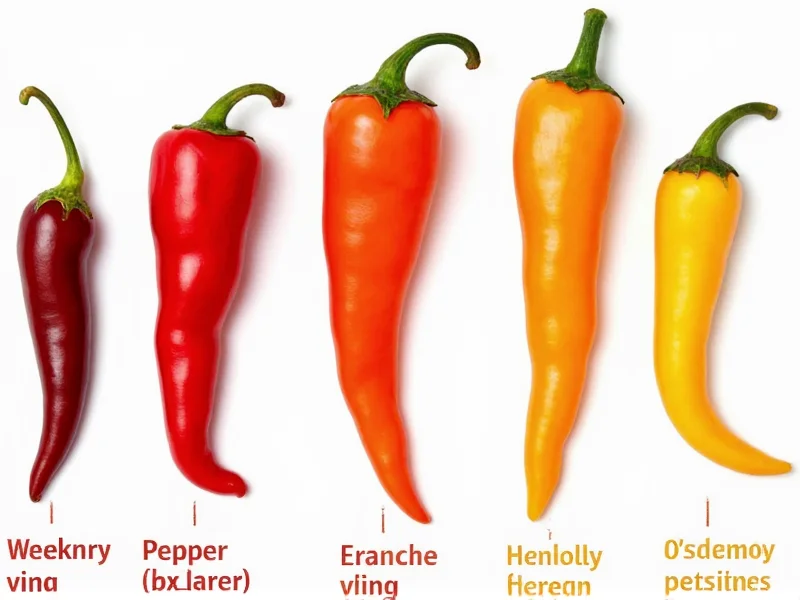Understanding pepper heat levels is crucial for cooks, gardeners, and spice enthusiasts who want to select the right chili for their needs without unpleasant surprises. This comprehensive visual reference guide presents the most common hot peppers in order of increasing heat, complete with identifying characteristics and practical usage tips.
The Science Behind Pepper Heat
Pepper spiciness comes from capsaicinoids, primarily capsaicin, which trigger heat receptors in our mouths. The Scoville scale, developed by Wilbur Scoville in 1912, measures the concentration of these compounds. Originally determined through human taste testing, modern labs now use high-performance liquid chromatography for precise measurements, reported in Scoville Heat Units (SHU).
Complete Hot Pepper Visual Reference Chart
| Pepper Variety | Visual Characteristics | Scoville Heat Units | Common Uses |
|---|---|---|---|
| Bell Pepper | Large, blocky shape; green, red, yellow, or orange | 0 SHU | Salads, stuffing, stir-fries |
| Pepperoncini | Yellow-green, wrinkled, curved | 100-500 SHU | Greek salads, sandwiches |
| Poblano | Large, dark green, heart-shaped | 1,000-2,000 SHU | Chiles Rellenos, mole sauce |
| Jalapeño | 2-3 inches, smooth green skin turning red | 2,500-8,000 SHU | Salsa, poppers, pickled |
| Serrano | Small, bright green, tapered | 10,000-23,000 SHU | Pico de gallo, hot sauces |
| Cayenne | Long, thin, red when mature | 30,000-50,000 SHU | Spice blends, hot sauces |
| Thai Bird's Eye | Small, pointy, bright red | 50,000-100,000 SHU | Thai curries, stir-fries |
| Habanero | Small, lantern-shaped, orange or red | 100,000-350,000 SHU | Caribbean sauces, hot sauces |
| Ghost Pepper (Bhut Jolokia) | Red, bumpy, wrinkled | 800,000-1,041,427 SHU | Extreme hot sauces, challenges |
| Carolina Reaper | Bumpy, red, with distinctive tail | 1,400,000-2,200,000 SHU | Competitive eating, specialty sauces |
Understanding Pepper Variability
It's important to note that Scoville ratings represent ranges rather than fixed values. Environmental factors significantly impact heat levels:
- Growing conditions: Stressors like inconsistent watering or nutrient deficiencies can increase capsaicin production
- Ripeness: Most peppers become significantly hotter as they mature from green to red
- Plant genetics: Even within the same variety, heat levels can vary between individual plants
- Part of pepper: The placenta (white ribs) contains the highest concentration of capsaicin, not the seeds
Practical Applications of the Pepper Heat Chart
When using this visual chart of spicy peppers in your kitchen or garden, consider these practical applications:
Cooking Guidance
Substitute peppers based on heat level when specific varieties aren't available. For example, if a recipe calls for serranos but you only have jalapeños, use approximately twice as many jalapeños to achieve similar heat. Remember that cooking doesn't reduce capsaicin levels significantly—spiciness remains largely intact during preparation.
Gardening Considerations
When planning your garden, arrange hot pepper plants from mildest to hottest to prevent accidental cross-pollination that could create unexpectedly hot hybrids. Keep in mind that ornamental peppers often pack surprising heat despite their attractive appearance.
Safety Precautions
When handling extremely hot peppers like ghost peppers or Carolina Reapers:
- Wear gloves to prevent capsaicin transfer to sensitive areas
- Avoid touching your face while preparing hot peppers
- Use dairy products (milk, yogurt) to counteract excessive heat if consumed
- Never use boiling water to clean cutting boards—capsaicin is oil-soluble, not water-soluble
Common Misconceptions About Pepper Heat
Several myths persist about hot peppers that this comprehensive hot pepper reference aims to clarify:
- Seeds = hottest part: The white pith (placenta) contains the highest concentration of capsaicin, not the seeds
- Color indicates heat: While red jalapeños are typically hotter than green ones, color alone doesn't determine heat across varieties
- Heat equals flavor: Many extremely hot peppers lack the complex flavor profiles of moderately hot varieties
- Water cools the burn: Capsaicin is oil-based, so dairy or starchy foods work better than water for relief
Building Your Pepper Tolerance
Regular consumption of moderately hot peppers can gradually increase your tolerance. Start with milder varieties like poblano or jalapeño, then progress to hotter options. Your body produces more endorphins with repeated exposure, making spicy foods increasingly enjoyable without the initial burning sensation becoming overwhelming.
Conclusion
This visual chart of hot peppers provides an essential reference for anyone working with chili peppers, whether in the kitchen or garden. By understanding the Scoville scale and visual characteristics of each variety, you can make informed choices that enhance your culinary creations without unpleasant surprises. Remember that personal heat perception varies, so always taste cautiously when experimenting with new pepper varieties.
Frequently Asked Questions
How accurate are Scoville scale measurements for home gardeners?
Scoville ratings provide general guidance but can vary significantly in home gardens due to growing conditions, soil quality, and water stress. A jalapeño that measures 5,000 SHU in one garden might reach 10,000 SHU in another with different conditions. Professional lab testing is the only way to get precise measurements.
Can I use a picture chart of hot peppers to identify unknown chilies in my garden?
Yes, a comprehensive hot pepper identification guide can help you identify unknown chilies by examining shape, size, color, and growth habit. However, be cautious with extremely hot varieties—never taste an unknown pepper to test its heat, as some ornamental peppers can be dangerously hot despite attractive appearance.
Why do some habaneros taste fruitier than others?
Habanero peppers come in various colors (orange, red, chocolate, yellow) that correspond to different flavor profiles. Orange habaneros tend to have classic citrus notes, while chocolate habaneros offer smoky, earthy undertones. The specific terroir where they're grown also influences their flavor complexity beyond just heat level.
Does cooking affect the Scoville rating of peppers?
Cooking doesn't significantly change the Scoville rating as capsaicin is heat-stable. However, preparation methods affect perceived heat: roasting can concentrate flavors, pickling may mellow heat slightly, and incorporating peppers into dishes with fats or dairy can make the heat feel less intense on the palate.











 浙公网安备
33010002000092号
浙公网安备
33010002000092号 浙B2-20120091-4
浙B2-20120091-4